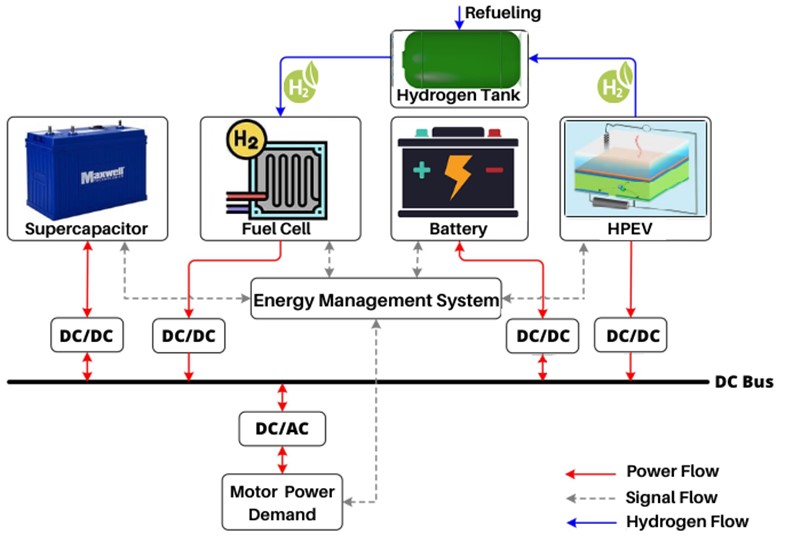In the pursuit of sustainable transportation, the utilization of renewable energy sources is crucial. To address the environmental impact of fossil fuels and the global energy crisis, the transition from conventional internal combustion engine (ICE) vehicles to hybrid electric vehicles (HEVs) is inevitable. HEVs combine multiple energy sources, such as hydrogen fuel cells (FC), supercapacitors (SC), batteries, and photovoltaic cells (PV), to optimize efficiency and reduce harmful emissions. Various hybrid energy storage system (HESS) topologies, including ICE-battery, ICE-battery-PV, FC-SC, SC-battery, FC-battery, and FC-SC-battery configurations, are introduced to enhance HEV performance. These designs aim to leverage the strengths of each energy source while mitigating their limitations.

Each energy source used in HEVs offers distinct advantages and disadvantages.
Hydrogen fuel cells provide high energy density and quick refueling times, making them suitable for long-haul transportation applications. They produce zero emissions, as their only by-product is water. However, hydrogen production requires dedicated infrastructure, and currently, the production process often relies on fossil fuels, resulting in carbon emissions. Additionally, the distribution and storage of hydrogen can pose challenges, limiting its widespread adoption. To cater this issue, electrolyzers are used which play a crucial role in the production of hydrogen for fuel cells, enabling clean and sustainable energy generation through the process of water electrolysis. Hybrid photoelectrochemical and voltaic cells (HPEV) produce electricity and hydrogen simultaneously. They can also be utilized to produce hydrogen for the FC for getting longer drive.
Supercapacitors offer high power density, allowing for rapid energy storage and release. They are well-suited for handling transient conditions like vehicle acceleration and capturing the braking energy. However, SCs have relatively low energy density, which means they store less energy compared to other technologies. They are best utilized in combination with other energy sources to compensate for their limited energy storage capacity.
Batteries, such as lithium-ion batteries, provide high energy density and can store a significant amount of electrical energy. They have become the primary energy storage solution in plug-in electric vehicles (PEVs). Batteries offer longer driving ranges and are more readily available than hydrogen refueling stations. However, they have limited lifespans, can’t cater for the transients when high energy is abruptly demanded and can experience performance degradation over time. Battery production also relies on the availability of raw materials, such as lithium, which may lead to supply chain challenges.
Photovoltaic cells, commonly known as solar cells, convert sunlight into electrical energy. They are a clean and renewable energy source, contributing to lower carbon emissions. PV systems can be integrated into the vehicle’s design, harnessing solar energy to power auxiliary systems and reduce the load on other energy sources. However, the energy generation of PV cells is dependent on sunlight availability, limiting their effectiveness in low-light or night-time conditions. Integration of PV technology into vehicles may supply energy especially when other sources have been exhausted but present design and space limitations.
By carefully considering the advantages and disadvantages of each energy source, hybrid electric vehicle manufacturers can optimize their designs to achieve sustainable and efficient transportation solutions.
Dr. Iftikhar Ahmad’s research focuses on a diverse range of topics within the field of energy and sustainability. With a notable presence in the academic community, he has contributed significantly to the advancement of knowledge in areas such as nonlinear control systems, renewable energy, hybrid energy systems, energy storage technologies, and sustainable transportation. His work explores the integration of different energy sources, such as fuel cells, supercapacitors, and batteries, to enhance the performance and efficiency of hybrid electric vehicles and grid systems. Additionally, he has delved into the development of novel energy storage systems and their integration with renewable energy technologies like photovoltaic cells.
FC-UC based has been proposed in the literature. Later Dr. Iftikhar and his team firstly added battery to enhance the energy storage. He has published numerous research papers on plug-in HEVs, electrolyzer based FC HEVs and he also used PV to generate hydrogen for the FC HEVs. His research offers valuable insights into the potential solutions and advancements needed for a more sustainable and greener future.
The author is Tenured Associate Professor at School of Electrical Engineering and Computer Science, National University of Sciences and Technology (NUST). He can be reached at iftikhar.rana@seecs.edu.pk.
Research Profile: https://shorturl.at/dgpqy

![]()






